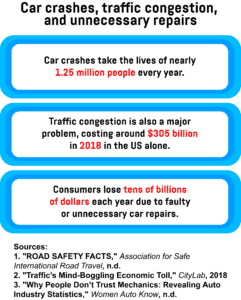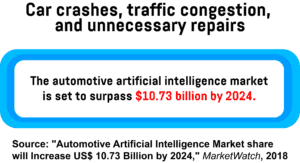- The automotive industry changes its approach to AI
- Intelligent algorithms at the wheel
- AI-powered tech improves the ride-sharing experience
- Machine learning tools prevent car problems
- AI makes it easier to detect vehicle damage
- Algorithms make roads safer
- Using quantum computers in traffic optimisation services
- Innovation is crucial in tackling transportation challenges
Cars are the bedrock of the modern world. And as the world becomes ever more connected, they’ll remain a crucial part of the global economy. But many processes related to cars are dysfunctional. Road crashes, for instance, cost the lives of nearly 1.25 million people each year. Unnecessary car repairs cost drivers billions of dollars and lead to higher insurance premiums and safety risks. Traffic congestion is also a major problem, and it incurred costs of around $305 billion in 2018 in the US alone. Fortunately, automotive companies, tech giants, startups, and public institutions are turning to innovative technologies such as artificial intelligence (AI) and quantum computing to find a solution to these problems.

Autonomous driving is one way to create safer roads. Intelligent vehicles would move at optimal speeds, reducing congestion and travel time. Furthermore, algorithms could also monitor engines and signal drivers when it’s time to visit a mechanic. And instead of time-consuming and stressful insurance claim procedures, AI solutions could automate the entire process, providing customers and insurers with better outcomes. Even quantum computers have a role to play in improving the transportation sector. These super-fast machines can analyse traffic data in milliseconds and instruct drivers on the fastest way to reach their desired destination. And as engineers come up with ever more innovative solutions, the way people develop, produce, sell, use, and maintain vehicles is set to change as well.
The automotive industry changes its approach to AI
Most automotive companies are aware of the potential of AI. In fact, over 80 per cent of them mention algorithms in their business strategies and vow to use this tech across multiple operations. The reality, however, is vastly different. Only 10 per cent of automotive businesses surveyed by the consulting firm Capgemini have deployed AI-powered solutions “with full scope and scale” in 2018, and “the industry has not made significant progress in AI-driven transformation since 2017.”

One reason for the slow adoption of AI might be that companies have changed their approach. Instead of investing hundreds of millions of dollars in various use cases to see which one will work, engineers are focusing on a smaller number of highly promising applications of smart algorithms. And if everything goes according to plan, the use of AI in the automotive industry is set to grow into a market worth more than a $10.73 billion-worth industry by 2024.
Intelligent algorithms at the wheel
From the US to Europe and Asia, carmakers and tech giants rely on algorithms to gain a competitive advantage. Hyundai, for instance, uses AI to relax drivers. The South Korean automaker has noticed that many drivers are anxious because the way in which adaptive cruise control accelerates or brakes feels unnatural and vastly different from how they usually drive a car. To make robotic driving more enjoyable, the company is developing a new system called Machine Learning-based Smart Cruise Control (SCC-ML). This tech will use sensors, cameras, and an onboard computer to learn about human drivers’ habits, like the rate of acceleration or typical following distance, and mimic their driving style.
As customers get used to having AI in the co-pilot’s seat, one day they might let algorithms take control of the steering wheel as well. Waymo, a subsidiary of Google’s parent firm Alphabet, is one of the leaders in this field. The company, valued at around $105 billion, has been running public tests in several US cities and its self-driving tech is considered one of the most advanced in the industry. Waymo’s AI software analyses data collected by the vehicle’s radar, cameras, GPS, and lidar to navigate through roads. The software can also predict the moves of pedestrians. If people are near the sidewalk, the car knows it needs to slow down, as someone might step into the street.
The electric vehicle producer Tesla also boasts impressive autonomous driving tech. Run by the visionary CEO Elon Musk, the company bets big on self-driving, and its vehicles can already autonomously brake, accelerate, and change lanes, although with active driver supervision. To navigate the vehicle, Tesla’s Autopilot software uses data from eight cameras and an array of sensors, sonars, and radars. The goal is to eventually produce fully autonomous vehicles that require no supervision. Getting to that point, however, will require regulatory approval and more advanced software, which might take years, if not decades, to deliver.
AI-powered tech improves the ride-sharing experience
Ride-sharing companies are also an important piece of the automotive industry ecosystem. Uber drivers alone complete 14 million rides each day, while Lyft drivers have completed one billion rides as of September 2018. Finding a way to optimise any part of these operations can yield huge profit. Lyft engineers, for instance, have developed algorithms that optimise rider-driver matching by identifying high demand areas. This feature enables drivers to get more rides and earn bonuses. Riders, meanwhile, benefit from faster and more convenient transport.
Uber uses AI to improve the pickup experience. The company developed One-Click Chat, a feature that analyses customer messages and provides drivers with several potential replies. For instance, if a driver is running late, the rider might send a message asking “Is everything OK? Are you coming soon?” Instead of drivers typing an answer, which is both risky and usually illegal, AI processes the message and provides multiple answer options that drivers can click on and let the customer know they’re late because of traffic congestion or a road accident, for instance.
Machine learning tools prevent car problems
Automobile manufacturers also use AI to prevent car problems. By analysing data from on-board sensors and connected vehicle parts, algorithms can spot potential problems before a total component failure and instruct drivers to visit the nearest repairman. Volkswagen is one of the car makers that’s developing such a predictive maintenance service in partnership with Microsoft. The duo will use AI and cloud technologies to monitor car performance and remotely install software updates for a range of different vehicle models.
https://www.youtube.com/watch?v=0IiecYI59Ig
The Volkswagen-owned car maker Audi is also investing in machine learning technologies. The company developed an algorithm that recognises and marks cracks in sheet metal parts during production, helping staff to fix the problem before the vehicle is shipped to customers. Software engineers used millions of test images to train AI to spot cracks. The research team eventually ended up with several terabytes of visual data that’s powering algorithms at Audi’s Ingolstadt plant. Until now, the inspection process was carried out manually and using smart cameras that had to be reconfigured for every new component and were prone to signalling false detections.
AI makes it easier to detect vehicle damage
Spotting cracks and damage in vehicles is important for the used car market, too. Used car buyers are rarely sure that the vehicle they just bought is without hidden problems. Undetected damage, overestimated repairs, and dealing with suspicious claims lead to billions of dollars of financial losses each year for car rental companies, dealers, and insurers. That’s why several startups use AI to help individuals and companies spot damages in the vehicles they buy or rent.
Ravin.ai, an Israel and UK-based tech firm, developed a software tool that analyses images taken by a smartphone or CCTV camera to spot damage in vehicles. The company’s co-founder and CEO, Eliron Ekstein says that algorithms can “expose any damages, and in many cases some underlying problems, reasons and repair action”. And this tech has many applications. Car rental firms can use it to monitor vehicles, find damage, and reduce repair costs. Used car buyers can rely on AI to expose hidden damage, while insurers can settle claims and cut down inspection costs in a faster and cheaper way.
Tractable is another startup that targets insurers. Its engineers have developed a program that uses computer vision to analyse images and assess the damage level in a vehicle. AI processes claims in a more efficient way and prevents inflated repair costs. But developing the algorithm was a challenging task, though. The company hired software developers, motor engineers, vehicle damage assessors, and insurance appraisers to receive a range of inputs and ensure that all major issues are tackled. These efforts resulted in advanced software that can be of great value to users and potentially save them a lot of money.
Algorithms make roads safer
Apart from analysing vehicles, AI can also monitor drivers. The Israeli startup eyeSight developed algorithms that analyse data from in-car cameras and infrared sensors to detect different types of driver behaviour. For instance, the software can detect whether the driver is in the car or not. Then, it detects which person is operating the vehicle and adjusts the seat, mirrors, and temperature accordingly. The AI can also recognise whether the driver is distracted and urge them to keep their eyes on the road, potentially saving their lives. It monitors drivers’ upper body posture, too, and ensures that airbags are deployed in a way that reduces injuries.
Google is another company that wants to keep drivers safe. Its Personal Safety app, which will be available on Pixel phones, can detect an accident by processing data from an accelerometer, a microphone, and many other sensors. When an accident occurs, the app will dial emergency services if there’s no response from the driver. But if users confirm that they’re not harmed, the app will abort the call. This technology could potentially save thousands of lives.
Using quantum computers in traffic optimisation services
Quantum computing is another cutting-edge technology that could transform the transportation sector, and Volkswagen is one of the first companies that has recognised its potential. The company is using a D-Wave quantum computer in traffic optimisation. Together with the Lisbon-based bus operator CARRIS, the German auto giant deployed quantum algorithms to calculate the fastest route for each individual bus in real time. The system also tracks the number of passengers and identifies stops with particularly high demand for public transport services, informing the operator when to increase the number of buses on the road.
Identifying and optimising the fastest routes for individual vehicles reduces traffic congestion. Also, it helps drivers to avoid traffic bottlenecks, ensuring that they get to their destination on time. But Volkswagen’s plans are bigger than that. The company believes that quantum-powered optimisation can benefit various companies, including taxi firms and fleet operators. After initial tests in Portugal, traffic optimisation projects will also be carried out in other European countries until the service is ready for commercial use.
Innovation is crucial in tackling transportation challenges
The modern world is built on the efficient movement of people and goods. Vehicles are essential for that purpose, but the transportation and automotive industries are riddled with inefficiencies. From unsafe roads to inefficient insurance claims processes, decades-old problems remain unresolved. The emergence of new technologies like AI and quantum computing, however, offers a way forward, as tech firms develop solutions that automate operations and provide everyone with better outcomes. Mastering new technologies isn’t easy, though. Companies have to invest millions of dollars in building new services, and market success is far from guaranteed. But innovation remains critical in tackling existing and future challenges and ensuring that people across the world can travel in a safe and reliable way.
Share via:


